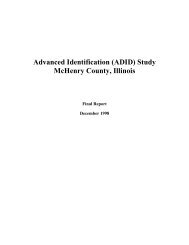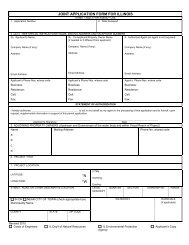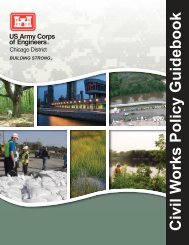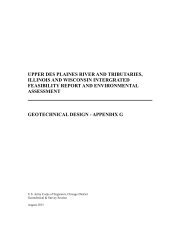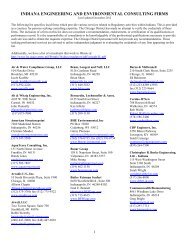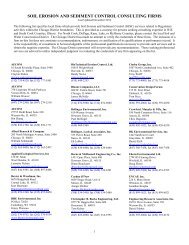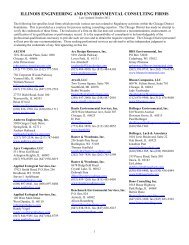Regional Permit Program - Chicago District - U.S. Army
Regional Permit Program - Chicago District - U.S. Army
Regional Permit Program - Chicago District - U.S. Army
You also want an ePaper? Increase the reach of your titles
YUMPU automatically turns print PDFs into web optimized ePapers that Google loves.
5) Involve dredging or filling beyond that required to install the shore protection.6) Impede public access to the shoreline.f. For repair and/or modification of a marine structure, provide the date the structure was originallyconstructed and a copy of the Department of the <strong>Army</strong> permit for the structure (if one was granted). Ifthe construction of the structure was not authorized by the <strong>District</strong>, an after-the-fact authorization shallbe sought.g. Temporary construction activities, including access roads and cofferdams, are not authorized under this<strong>Regional</strong> <strong>Permit</strong>.h. The construction of multi-user pier and docking facilities and related appurtenances within Section 10waters are not authorized under the RPP.12. BRIDGE SCOUR PROTECTIONRP12 authorizes the construction and installation of protective armoring at existing bridge foundations,abutments and/or around bridge piers of “Scour Critical Bridges” as designated by the Federal HighwayAdministration (FHWA). Authorization under RP12 is subject to the following requirements which shall beaddressed in writing and submitted with the notification:a. All projects will be processed under Category I.b. Protective armoring may include riprap, broken concrete, formed concrete pieces, concrete filled fabricmats, gabions, or other engineered designs consistent with reasonable engineering standards. Shouldbroken concrete be used, all reinforcing rods shall be cut flush with the surface of the concrete. Theprotective armoring may extend riverward of the adjacent shoreline or any adjacent existing seawalls,gabion structures, or riprap covered banks and may extend above the existing streambed up to theOrdinary High Water Mark (OHWM) of the River. Material excavated for the construction of theprotective armoring shall be disposed of in accordance with Federal, State and local laws andordinances, and shall not be placed in a floodway or in any waters of the U.S., including wetlands.c. Temporary construction access may be obtained over the side of the bridge, by use of temporary roadsor pads constructed of clean fill, by use of mats, or from barges or floating platforms. All material usedfor temporary access shall be removed from the site immediately upon completion of work in anysegment of the project. All portions of the site shall be restored to preconstruction conditions.d. All temporary construction activities shall adhere to the requirements of items c through i of <strong>Regional</strong><strong>Permit</strong> 7 (Temporary Construction Activities) and shall be addressed in writing and submitted with thenotification.e. Projects in special aquatic sites (e.g., wetlands, mud flats, vegetated shallows, and riffle and poolcomplexes, etc.) shall be conducted with no more than minimal adverse environmental effects.f. All designated work area(s) shall be drawn onto the submitted construction plans and clearly labeled.g. If, in the determination of the <strong>District</strong>, the protective armoring may constitute an undue hazard,obstruction to navigation, or if it is deemed that the project may not be in the public interest, anIndividual <strong>Permit</strong> may be required.33



